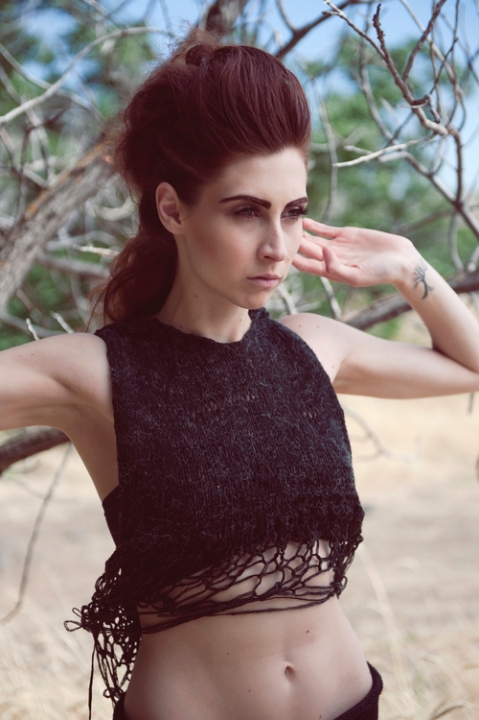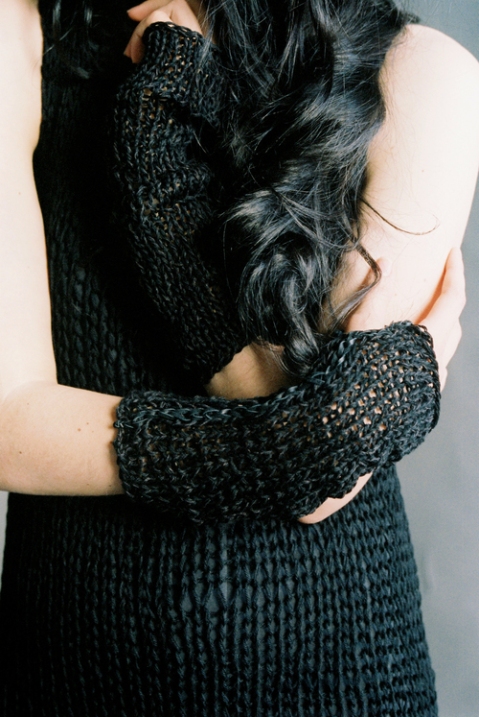Interview with Angela Thornton of Morph Knitwear
April 1, 2014 § Leave a comment
Morph Knitwear is Angela Thornton’s line of hand-knitted clothing and accessories, a deeply emotional and personally expressive exploration of death and darkness in physical form. Each of her “cocoons of dark material,” as she puts it, allow her to learn more about herself and reach out to similar people who find beauty in destruction, decay, and the mysterious. “To me,” she says, “knitting a garment from a single strand of fiber is an integral part of coming to some sort of understanding, and creating a garment that speaks to the darkness of others is part of its procession.”
What does your office/studio look like? What kinds of things do you keep around you for inspiration? What kinds of soundscapes do you surround yourself with?
My office/studio space is a motley collection of desks, shelves, and cabinets scrounged from free piles on the street and my relatives basements. It’s utilitarian and covered in piles of yarn. I have other independent artists’ work hanging on the walls, stacks of books on my desk, and candles in empty booze bottles scattered about. I tend to operate in a total chaotic mess, it makes sense to me, though I think I would like it if I had the inclination to be a more organized human. I listen to a lot of heavy metal while I’m working, but depending on my mood I’ll interject anything from Fleetwood Mac to Beyonce into my soundtrack. Really though it’s mostly heavy stuff.
What does a typical workday look like for you? What is your schedule like?
A typical workday for me usually starts around noon, or maybe 2 pm if I have a lot of errands to run in the morning. I will usually do my online business first, then I turn on music, Netflix, or an audiobook and knit until its bedtime. Lucky for me I work from home and have a wonderful partner who reminds me to eat lunch and dinner! My schedule is mostly comprised of me knitting. It’s what I do with 90% of my time, probably.
What kinds of software and computing devices, if any, do you use to get your work done?
It’s funny because I feel that this question isn’t really applicable to me, but if it weren’t for the internet, my computer, and my iphone I would not have any sort of business at all. So I suppose that internet access has created a space for my business and passion to exist.
What internet spaces do you feel help you the most with your business?
Definitely social media sites like Instagram, Pinterest, and Tumblr.
What kinds of tools do you use? How do you use them? What is your creative process like?
My creative process starts with an itching need to get a new idea out into the physical world. I work with yarn of all types, hand knitting materials (so, knitting needles, crochet hooks, etc) as well as a hand run knitting machine. I’m hilariously bad at drawing and sketching, so I generally write out an idea with a rough outline of what the garment would look like, and then I begin experimenting. Most every garment I create has gone through 2 or 3 revisions before I’m happy with the way it is, so it’s a laborious (though totally necessary) process.
What kind of mental processes help you get work done?
I have this itching desire to make things, so even without any outside stimulus I always have that drive. That being said, seeing the products that other independent designers release really inspires me to always be challenging myself to be better. On an every day level I have a time limit within which I have to fill orders and create garments, so I operate on a sort of “there’s work to be done, so do it, damn it” mental process.
What does “handmade” mean to you?
To me handmade means exactly that, something made by hand. In terms of my process it means that I am taking lengths of string, essentially, and by hand creating fabric in the shape of a garment. Handmade, in my case, means that every stitch in every garment was manipulated, created, and touched by my hands, and created by my mind.
How far do you feel something can be automated or outsourced before it is no longer handmade? What do you feel is the role of intent/passion in determining if something is handmade?
I think that collective groups of people working together with the necessary tools/machines of their trade is as far as I’d go in allowing something to remail titled ‘handmade’. Once large scale production kicks in I feel that it ethically isn’t handmade anymore. Passion and intent for both the product and social / environmental impact of the product definitely has a lot to do with keeping something handmade.
What inspires you in the creation of your objects?
This is always a tricky question for me to answer! I suppose my innate need to create is what drives me, but anything from mythology to music to another clothing brand inspires me. I have a very particular aesthetic that I have grown into and things that resonate with that aesthetic, be it a song or a natural landscape are my inspiration.
Can you tell me more about this aesthetic? Do you feel there is a name you could give it?
I guess I’d describe it as being dark and powerful. I am particularly drawn to pieces (art, furniture, clothing, etc) that embody fierce, tough power at the same time as presenting poise and elegance. Particularly when it comes to what I wear I’d describe this aesthetic as one that balances between biker and ancient prophetess.
What do the objects you create mean to you?
The things I make are really just an extension of me, I think. They are meant to be utilitarian, evocative, and special to the wearer, but essentially they come from a deeply personal creative space within me, and the process of creating them only accentuates that. I hope that the wearer of my knitwear feels that personal connection, but also redefines the garment to her individuality.
What do the materials you use mean to you?
I use materials that fit my particular aesthetic, ones that evoke the tough elegance that I think defines my work. I love to work with natural fibers because they are so versatile and there’s such a textural range to be explored there, but I’m not stuck in that, I’ll basically knit with anything if it gives me the end result I’m looking for.
How do you transfer your material presence, in terms of your self and your handmade objects, to the digital world?
Mostly through the use of my trust old iphone! I like to do collaborations with photographers, models, other artists, etc for larger projects like lookbooks, but for my everyday presence I generally transmit my work through social media via my phone or computer.
How do you balance the physical and the digital? Do you prefer digitized media or analog media, etc.?
Digitized media is easy and a wonderful way for me to give access to my work without a huge overhead cost, so I definitely am grateful for that, and really enjoy the freedom it enables.
How do you use the internet to connect with others interested in the same kind of work and aesthetic? How do you interact with them offline?
The internet is such a core part of my business, social media being the most important facet of that. I run a one woman business, so I like to personally connect with those interested in my work and aesthetic. As my work has become more visible online, I’ve found myself surrounded by a really wonderful supportive community who have really blown my mind with their encouragement. That online community translates directly to the offline one- I’ve been able to meet and work with both clients and other designers, and so many of them have become wonderful friends in that process. The independent design community is a wonderful international thing that I feel so happy to have stumbled into and been blessed by.
Do you consider yourself part of a subcultural community? What name would you give it?
I suppose I’m part of the slow fashion subculture, which is subcultural in the sense that it isn’t part of the instant gratification driven traditional consumer culture. I personally am very against huge corporation, especially in terms of fashion and clothing. The social, environmental, and economic injustice of huge capilalist clothing companies appalls me, and so I’m passionate about encouraging a culture of artisan craftsmanship when it comes to what we wear.
How would you say your personal aesthetic fits in with the slow fashion subculture? Do you feel that artisans who have more niche visual styles are more likely to be into slow fashion, or do you feel that the aesthetic style of an artisan is independent of their belonging to the slow fashion subculture? Why?
I don’t think being part of the slow fashion movement has anything to do with any particular aesthetic. I think it has much more to do with the creator’s intent, and their desire to not be part of the traditional capitalist structure than what their particular product looks like. My aesthetic is one that’s common to a group of people, and luckily out of that group of people there are ones who want to support independent designers and artisans- again, I think it has more to do with the intent of the consumer converging with the intent of the creator, versus any particular “look” being the driving force.
You can find Morph Knitwear on its website, Etsy, Facebook, Twitter, and Instagram!




Leave a comment